
|
Methods of Preventing Corruption: A Review and Analysis of Select Approaches
|
This literature review provides a comprehensive summary of methods commonly used to prevent corruption in both the private and public sectors and where possible, provides insight on which preventative methods have empirical value and demonstrated effectiveness.
| 2023-12-08 |

|
Research Summary - Methods of Preventing Corruption: A Review and Analysis of Select Approaches
|
This research summary provides a summary of methods commonly used to prevent corruption in both the private and public sectors and where possible, provides insight on which preventative methods have empirical value and demonstrated effectiveness.
| 2023-12-08 |

|
Patterns in Cannabis Cryptomarkets in Canada in 2018
|
This report examines cannabis cryptomarkets in 2018 – the year Canada legalized cannabis. Are there early signs of changes in the supply side?
| 2019-10-25 |

|
Research Summary - Patterns in Cannabis Cryptomarkets in Canada in 2018
|
This report examines cannabis cryptomarkets in 2018 – the year Canada legalized cannabis. Are there early signs of changes in the supply side?
| 2019-10-25 |
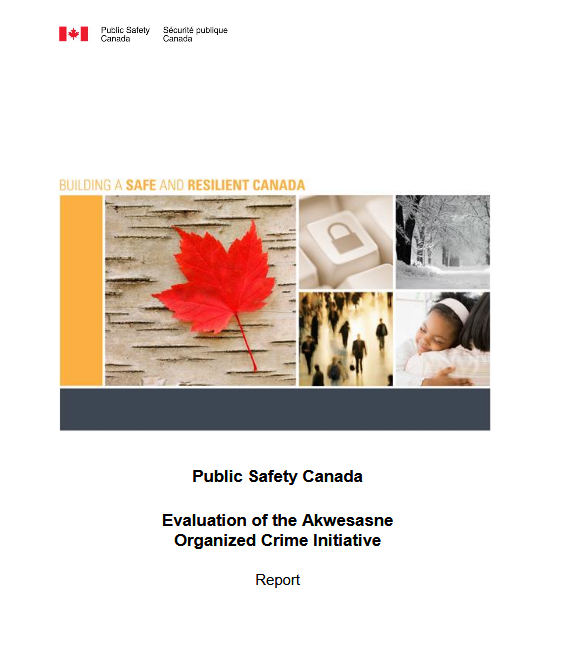
|
Evaluation of the Akwesasne Organized Crime Initiative
|
This report presents the results of the Evaluation of the Akwesasne Organized Crime Initiative.
| 2019-05-22 |

|
Summary of the Evaluation of the Akwesasne Organized Crime Initiative
|
The evaluation assessed the Initiative's achievement of outcomes, design and delivery, and the efficiency and economy of program administration.
| 2019-05-22 |

|
Research Highlights - Crime Prevention : Transitions From Juvenile Delinquency to Young Adult Offending: A Review of Canadian and International Evidence
|
This document reviews longitudinal research on key questions concerning transitions from juvenile delinquency to young adult offending.
| 2018-02-23 |

|
Research Summary - Transitions From Juvenile Delinquency to Young Adult Offending: A Review of Canadian and International Evidence
|
This review examines Canadian and international longitudinal studies concerning the transition from juvenile delinquency to young adult offending.
| 2018-02-23 |
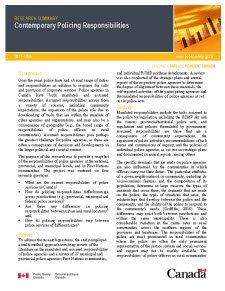
|
Research Summary - Contemporary Policing Responsibilities
|
The purpose of this research was to provide a snapshot of the responsibilities of police agencies at the national, provincial, and municipal levels, and in First Nations communities.
| 2018-02-23 |
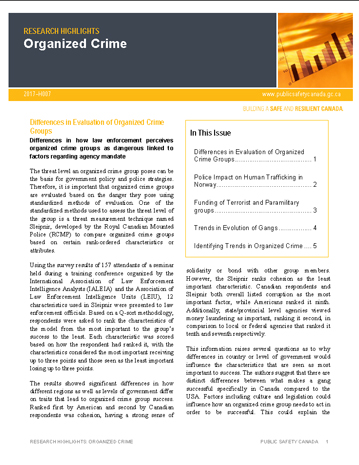
|
Organized Crime – Research Highlights 2017-H007
|
The study highlights the differences in evaluation of Organized Crime Groups; Police Impact on Human Trafficking in Norway; Funding of Terrorist and Paramilitary groups; Trends in Evolution of Gangs; Identifying Trends in Organized Crime.
| 2018-02-23 |

|
Research Summary: Programme de suivi intensif de Montréal – Gangs de rue [Montreal Intensive Supervision Program – Street Gangs]
|
Evaluation of the impact of an intensive supervision program on offending behaviours and criminogenic risks, social integration, and the level of engagement in street gangs among young offenders aged 15 to 25, including a descriptive cost analysis and a cost-effectiveness study.
| 2017-11-10 |

|
Organized Crime – Research Highlights 2017-H006
|
The Territorial Expansion of Mafia Style Organized Crime; Intervening in the Recruitment Pathway as a Response to Organized Crime; Policy Effects in Transnational Illicit Markets; Monitoring Online Offenders; A Typology for ‘Polymorphous Criminal Networks' and Diversification or Co-occurrence.
| 2017-10-12 |
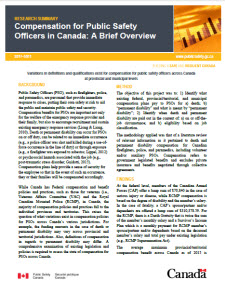
|
Research Summary: Compensation for Public Safety Officers in Canada: A Brief Overview
|
The objective of this project was to: 1) Identify what existing federal, provincial/territorial, and municipal compensation plans pay to PSOs for a) death; b) “permanent disability” and what is meant by “permanent disability”; 2) Identify when death and permanent disability are paid out in the context of: a) on or off-the-job circumstance; and b) eligibility based on job classification.
| 2017-07-07 |
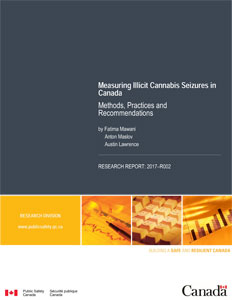
|
Measuring Illicit Cannabis Seizures in Canada
|
The objective of this project is to examine the current methods of measuring the metric of cannabis seizures with particular attention paid to the way seizure information is recorded by law enforcement as well as to discuss the potential improvements to the way we currently measure the metric of cannabis seizures.
| 2017-06-13 |

|
Research Summary - Measuring Illicit Cannabis Seizures in Canada
|
The objective of this project is to examine the current methods of measuring the metric of cannabis seizures with particular attention paid to the way seizure information is recorded by law enforcement as well as to discuss the potential improvements to the way we currently measure the metric of cannabis seizures.
| 2017-06-13 |

|
The Price of Cannabis in Canada
|
The current report provides estimates of: 1) cannabis prices from 2011 to 2015; and 2) the price elasticity of cannabis demand in Canada.
| 2017-06-13 |

|
Research Summary - Price of Cannabis in Canada
|
The current report provides estimates of: 1) cannabis prices from 2011 to 2015; and 2) the price elasticity of cannabis demand in Canada.
| 2017-06-13 |

|
Organized Crime - Research Highlights 2016-H004
|
Criminal Network Disruption; Using Social Network Analysis to Money Laundering Detection; Challenges Faced in Counter Cybercrime Operations; The Structure of Quebec's Synthetic Drug Market; Understanding the Development of Illegal Enterprises
| 2017-06-06 |

|
Deportation, Circular Migration and Organized Crime - Haiti Case Study
|
Like all OECD countries, Canada has a policy of deporting immigrants who have committed certain kinds of crime back to their countries of origin. This pattern of circular migration—immigration to Canada followed by deportation—has unique implications for the development of transnational organized crime.
| 2016-09-29 |

|
Ways to Consider Non-Medical Cannabis - Reasoning from Conceptual Analogues
|
The objective of this report was to identify the similarities and differences between psychoactive cannabis and analogous legal substances consumed for their psychoactive properties, and describe the characteristics applied when discussing or fashioning regimes related to the control of these substances in order to identify approaches and considerations for consultation and policy discussion.
| 2016-09-27 |
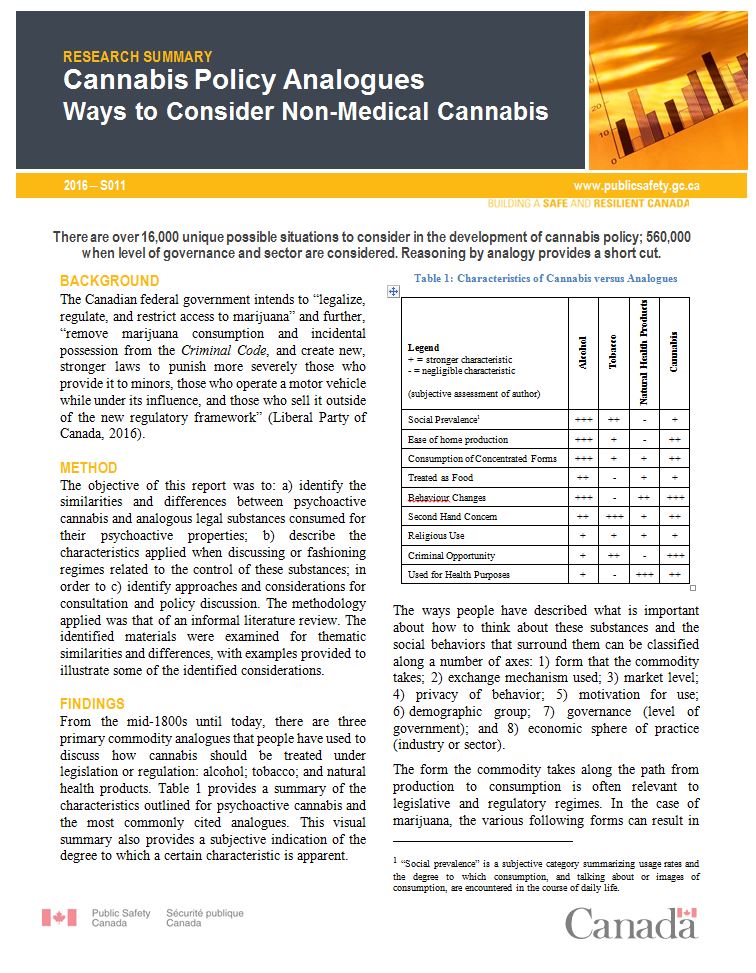
|
Research Summary: Cannabis Policy Analogues - Ways to Consider Non-Medical Cannabis
|
The objective of this report was to identify the similarities and differences between psychoactive cannabis and analogous legal substances consumed for their psychoactive properties, and describe the characteristics applied when discussing or fashioning regimes related to the control of these substances in order to identify approaches and considerations for consultation and policy discussion.
| 2016-09-27 |
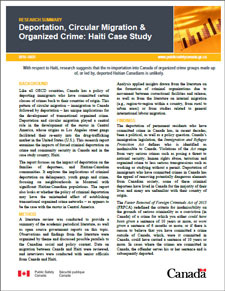
|
Research Summary - Deportation, Circular Migration and Organized Crime: Haiti Case Study
|
With respect to Haiti, research suggests that the re-importation into Canada of organized crime groups made up of, or led by, deported Haitian Canadians is unlikely.
| 2016-09-16 |

|
Research Summary: Deportation, Circular Migration and Organized Crime: Honduras
|
Canadian immigration policy requires that non-citizens who have committed serious crimes be removed from Canada and returned to their country of origin.
| 2016-04-18 |

|
Deportation, Circular Migration and Organized Crime: Honduras Case Study
|
This research report examines the impact of criminal deportation to Honduras on public safety in Canada.
| 2016-04-18 |

|
Deportation, Circular Migration and Organized Crime: Jamaica
|
The report reviews the impact of forced deportations, criminal and otherwise, on public security and organized crime in Canada and Jamaica, with a focus on transnational connections between deportees, organized crime and Canada.
| 2016-04-18 |

|
Deportation, Circular Migration and Organized Crime Jamaica Case Study
|
This report reviews the impact of forced deportations, criminal and otherwise, on public security and organized crime in Canada and Jamaica, with a focus on transnational connections between deportees, organized crime and Canada.
| 2016-04-18 |
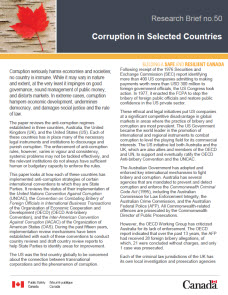
|
Corruption in Selected Countries - Research Brief no. 50
|
Corruption seriously harms economies and societies; no country is immune. While it may vary in nature and extent, at the very least it impinges on good governance, sound management of public money, and distorts markets. In extreme cases, corruption hampers economic development, undermines democracy, and damages social justice and the rule of law.
| 2014-11-21 |
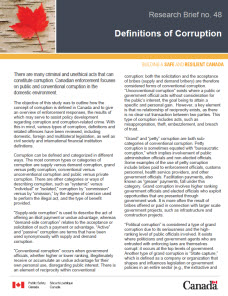
|
Definitions of Corruption - Research Brief no. 48
|
There are many criminal and unethical acts that can constitute corruption. Canadian enforcement focuses on public and conventional corruption in the domestic environment.
| 2014-11-21 |

|
Organized Crime Research Highlights Number 7
|
Alliances and Conflicts in Street Gangs; Solving Gang Homicides; Counting Drug Users; Regulating Illicit Markets; Economic Cost of Organized Crime; Reducing Offending Opportunities
| 2014-06-24 |

|
Witness Protection Programs in Selected Countries - Research Brief no. 43
|
Effective witness protection is a cornerstone of the criminal justice system in the fight against organized crime. Traditional witness protection focuses on the safety of the witness. Experience shows, however, that individuals are not willing unless they have confidence that the State will protect their rights and safety as well as those of their immediate family.
| 2014-06-17 |

|
Organized Crime Research Highlights Number 6
|
Deterrence and Criminal Lifestyles; Drug Market Money-launders; Evaluation of U.S. Anti-Gang Initiatives; Co-offending Patterns and Organized Crime; Production of Synthetic Drugs in Quebec
| 2014-05-28 |

|
Organized Crime Research Highlights Number 5
|
Anonymous Online Marketplace for Illicit Goods; Victim-Offender Mediation and Organized Crime; Locating the Source of Diffusion in Large-Scale Networks; Drug Market Disruption and Violence; Quebec's Synthetic Drug Market
| 2013-10-29 |

|
Organized Crime Research Highlights Number 4
|
Internet-facilitated Counterfeit Crime; Violence and Gang Territories; Measuring Police Impact on Organised Crime; Locating Meth Labs; Strategic Intelligence and Transnational Organised Crime; Sizing Drug Markets using Sewage.
| 2013-07-18 |
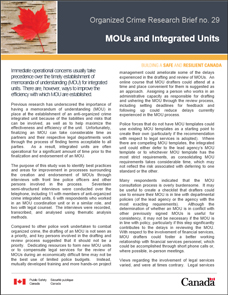
|
MOUs and Integrated Units (OCRB no. 29)
|
The purpose of this study was to identify best practices and areas for improvement in processes surrounding the creation and endorsement of MOUs through interviews with front line police officers and other persons involved in the process. Key findings: Immediate operational concerns usually take precedence over the timely establishment of memoranda of understanding (MOU) for integrated units. There are, however, ways to improve the efficiency with which MOU are established.
| 2013-02-12 |

|
Data mining for Possible Organized Crime (OCRB no. 28)
|
This study combined computational mathematical analysis, social network analysis methods, and data mining techniques in a unique way to automatically identify traces of possible criminal organizations in operational police records. Key findings: A method of data mining regular police records to identify possible criminal organizations has been developed. Between 2001 and 2006, offending related to 236 possible criminal organizations was reported to RCMP "E" Division, with 39 of the groups being particularly serious.
| 2012-11-05 |

|
Organized Crime Research Highlights Number 3
|
How identities are traded online; Differences between organized criminals and other offenders; White-collar crime and the global financial meltdown; Combating transnational environmental crime; Co-offending between criminal enterprise groups; Using math to estimate the gang affiliation of unknown offenders; Comparing the illicit trades in wildlife and drugs.
| 2012-06-25 |

|
Organized Crime Research Highlights Number 2
|
Criminal cooperation between organized crime groups; Do all gangs pose equal security risks in correctional facilities? ; Motives and methods for leaving a gang; Who stops dealing hard drugs?; Using wiretap data to understand criminal organizations; Effectively dismantling a drug syndicate using network structure and role; and Organized crime involvement in the illicit antiquities trade.
| 2012-02-24 |
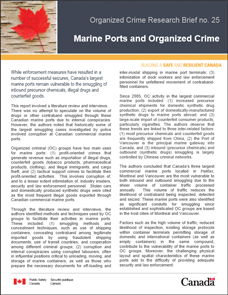
|
Marine Ports and Organized Crime (OCRB no. 25)
|
Through the literature review and interviews, the authors identified methods and techniques used by OC groups to facilitate their activities in marine ports. Key findings: While enforcement measures have resulted in a number of successful seizures, Canada's largest marine ports remain vulnerable to the smuggling of inbound precursor chemicals, illegal drugs and counterfeit goods.
| 2012-02-16 |

|
Securities and Organized Crime (OCRB no. 26)
|
This report is based on a review of the academic literature, interviews with law enforcement, and securities regulators, and legislation and regulations governing Canadian securities markets. Key findings: Evidence of traditional organized crime in securities markets is scarce, but the industry is vulnerable to fraudulent activity perpetuated by market insiders.
| 2012-02-16 |

|
Commercial Construction and Organized Crime (OCRB no. 27)
|
This report is based on a literature review, interviews and a descriptive analysis of economic data from the commercial construction sector in British Columbia and Quebec. Key findings: The economic and regulatory environment in which the Canadian commercial construction sector operates is at moderate to high risk of corruption and organized criminal activity.
| 2012-02-16 |

|
Canada's Role in the Global Meth Market (OCRB no. 23)
|
This research represents a first step towards discovering a more reliable measurement of Canada's role as a producer and exporter in the global ATS market. Key findings: According to preliminary estimates, Canada produces 0.6 – 4.6% of the world's supply of amphetamine-type stimulants, including ecstasy. This finding suggests that Canada is not a major global exporter of amphetamine-type stimulants.
| 2012-02-13 |

|
Organized Crime Research Highlights Number 1
|
Social Network Analysis in Operations; Current Proposed Australian Unexplained Wealth Regimes; Criminal Trajectories in Organized Crime; Mortgage Origination Fraud and the Global Economic Crisis; More Organizationally Complex Gangs: Committing More Crime?; Traffic in Garbage and Hazardous Waste: An Overview; Precursor Laws Effect on Methamphetamine Production
| 2011-11-03 |

|
Witness Protection Programs (OCRB no. 1)
|
This review compared the characteristics and operations of witness protection in selected countries, as well as the successes and challenges they face. Key Findings: Around the world most witness protection programs are managed by police forces. Witness intimidation is usually perpetrated by criminal organizations. Most protected witnesses are criminally-involved.
| 2011-10-28 |

|
POP and Securities Fraud (OCRB no. 2)
|
The authors of this report outlined a problem-oriented approach to securities fraud and considered the involvement of organized crime in such offenses. Key findings: Problem-oriented policing (POP) has not been systemically applied to securities fraud in Canada. Offenders are generally white, well-educated males who specialize in white-collar crime, and who move often. Seniors are common victims; people are often repeatedly victimized.
| 2011-10-28 |

|
Sizing Meth and MDMA Markets (OCRB no. 3)
|
The purpose of this report was to re-examine the scientific and grey literature on current methods of estimating the size of illegal markets, with an emphasis on the meth/MDMA markets. Key findings: There are no good estimates of the size of Canadian meth and ecstasy markets. Multiplier and capture-recapture methods may be able to estimate number of users and sellers, as well as quantity consumed and exported.
| 2011-10-28 |

|
Mobility of Criminal Groups (OCRB no. 4)
|
This report examined the findings from past research that posited themes and theories regarding the shifts and patterns in the mobility of criminal groups. Key findings: Criminal groups are more self-organizing and emergent than strategic when setting up in new locations. Preventing criminal opportunities can stifle the migration of organized crime.
| 2011-10-28 |

|
POP and Outdoor Cannabis (OCRB no. 5)
|
The purpose of this report was to outline how the principles of POP might be applied to disrupting and preventing the operation of outdoor marijuana grow operations (OMGOs) controlled by organized crime groups within Canada. Key findings: As with indoor grow operations, particular resources and circumstances are required for growing cannabis outdoors. Understanding offending patterns can lead to novel suppression and disruption strategies.
| 2011-10-28 |

|
Counter-measure Effects (OCRB no. 6)
|
This report expanded on the body of research on organized crime (OC) counter-measures and reviewed how law enforcement operations targeting organized crime are evaluated. Key findings: Police operations against organized crime have limited to no measurable impact on the public's perception of safety or recorded levels of crime at the city-wide level.
| 2011-10-28 |

|
Factors Shaping Organized Crime (OCRB no. 7)
|
This report assessed a number of individual, group, and environmental level variables that may influence how individuals or groups structure their criminal operations in a variety of criminal markets and legitimate settings. Key findings: The structure of organized crime can tell us about available criminal opportunities and criminal operations, as well as the enforcement environment. Group structure is a result of external factors, mitigated by individual resources and decision making.
| 2011-10-28 |

|
Integrated Anti-Organized Crime Units (OCRB no. 8)
|
The purpose of this study was two-fold: (a) compilation of a current inventory of all integrated teams and units operating in Canada; and (b) a more detailed qualitative analysis of a subset of these units to better understand their operating procedures, challenges, and keys to success. Key findings: As of 2009, there were 157 integrated organized crime units. Clarity and consistency on the roles and responsibilities of partners and team members is the key to their success.
| 2011-10-28 |

|
Literature Review on Organized Crime (OCRB no. 9)
|
This report examined academic research being conducted world-wide on addressing organized crime, as of 2009. Key findings: Organized crime largely exists due to illicit markets. The application of violence by organized crime is cyclical. There is no consensus on how to measure the harm of organized crime.
| 2011-10-28 |

|
Training Needs to Combat Organized Crime (OCRB no. 10)
|
This report provided an understanding of the perspectives of policy makers, prosecutors, and law enforcement personnel regarding most urgent training requirements, as well as their suggestions for future training which would assist them with identifying and conducting intelligence on, and prosecuting those engaged in, organized criminal activities. Key findings: Shared experience and information makes for effective training. Cross-institutional and co-training models are promising. Introductory courses and seminar series are suggested.
| 2011-10-28 |

|
Creating an Organized Crime Harm Index (OCRB no. 11)
|
The primary goal of this study was to assess the feasibility and utility of developing and applying rigorous methodological and analytical models that could reliably measure the harm of organized crime in Canada. Key findings: Insufficient quantifiable data exists to reliably measure the scope and harm of organized crime in Canada. Detailed self-reported victimization data and data on illicit markets are required. Proxy estimates or indicators may be useful.
| 2011-10-28 |

|
Defining Street Gangs (OCRB no. 12)
|
The primary purpose of this report was to discuss the difficulties related to the identification of gang members and gang-related crimes in Canada, and provide an overview of how gangs have been previously defined by academic researchers, law enforcement agencies and government policy-makers. Key findings: Many different definitions of "gang" and "street gang" are in use. Differences can hinder gang suppression and prevention activities. A proposed, common ground definition is nearly identical to the "criminal organization" definition in the Criminal Code of Canada.
| 2011-10-28 |

|
Gangs and Social Networking (OCRB no. 13)
|
The main purpose of this report was to explore how social media can assist in understanding the functioning and activities of criminal groups, the magnitude of the current and future threats posed by such groups' usage of new communications technology, and potentially provide a reasonable set of options for combating this problem. Key findings: Gang members generally use social networking sites individually to promote gang culture or individual reputations, not to collectively arrange offending or recruit members. Law enforcement monitoring of social networking sites is useful for policing gangs.
| 2011-10-28 |

|
Addressing Street Gangs (OCRB no. 14)
|
The goal of this report was to present some ideas about the best ways to deal with street gangs in Canada. Key findings: Comprehensive gang crime reduction strategies target crime with prevention, intervention and suppression efforts. Single strategy programs have been of limited effectiveness.
| 2011-10-28 |
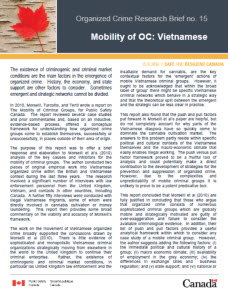
|
Mobility of Organized Crime: Vietnamese (OCRB no. 15)
|
The goal of this report was to present some ideas about the best ways to deal with street gangs in Canada. Key findings: Comprehensive gang crime reduction strategies target crime with prevention, intervention and suppression efforts. Single strategy programs have been of limited effectiveness.
| 2011-10-28 |

|
Mobility of Organized Crime: Cammora (OCRB no. 16)
|
The purpose of this report was to test framework of Morselli, Turcotte, and Tenti against a recent case study on the movement of a Camorra crime group from Campania (Italy) to Scotland and the Netherlands. Key findings: Organized crime groups that are predatory or provide an illicit good or service transpose their operations differently, and for different reasons. Varied types of movement - of individuals, branches, or headquarters - require separate consideration.
| 2011-10-28 |
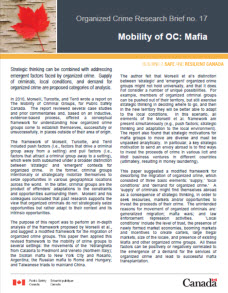
|
Mobility of Organized Crime: Mafia (OCRB no. 17)
|
The purpose of this report was to perform an in-depth analysis of the framework proposed by Morselli et al., and suggest a modified framework for the migration of organized crime groups. Key findings: Strategic thinking can be combined with addressing emergent factors faced by organized crime. Supply of criminals, local conditions, and demand for organized crime are proposed categories of analysis.
| 2011-10-28 |

|
Street Gang Control Strategies (OCRB no. 18)
|
This report involved a systematic literature review as well as an attempted meta-analysis of evalutations of street gang control strategies. Key findings: Not enough empirical evaluations have been done of gang control strategies to perform a statistical meta-analysis. Programs are more effective when they are directed at specific populations, particularly chronic gang members. The empirical effectiveness of the Spergel Model is questioned.
| 2011-10-28 |

|
Ways to Measure Cyber-Fraud (OCRB no. 19)
|
The primary goals of this study were to assess the potential for using innovative methodologies to estimate the scope of cyber-fraud, to identify existing data sources and gaps, and to suggest novel sources of data that may help provide an accurate and fulsome picture of the nature and prevalence of cyber-fraud in Canada. Key findings: Cyber-fraud data is collected by a variety of organizations, including banks, regulatory agencies, and various police agencies. Often it is not collected at all. A study of offender network structures could be applied to methods of identifying hidden populations of cyber-fraud offenders.
| 2011-10-28 |

|
Understudied Areas of Orgranized Crime (OCRB no. 20)
|
Understudied areas of organized crime include how organized crime groups spend their money, environmental crime, wildlife crime, organized crime infiltration in legitimate enterprises and markets, the counterfeiting of goods, and online gambling. Key findings: Understudied areas of organized crime include how organized crime groups spend their money, environmental crime, wildlife crime, organized crime infiltration in legitimate enterprises and markets, the counterfeiting of goods, and online gambling.
| 2011-10-28 |

|
Social Media and Organized Crime (OCRB no. 21)
|
This research complements existing empirical information regarding the use of social media by criminal organizations and by police by way of literature review and interviews with police and social media experts. Key findings: Persons suspected of organized crime involvement do not tend to display their illicit activities on their social media profiles, but instead use social media to keep connected to their friends, families, and to share their interests. Police, on the other hand, employ social media to connect to the communities that they serve and as an investigative tool.
| 2011-10-28 |

|
Working Together to Combat Organized Crime
|
This report provides a brief overview of the scope of serious and organized crime in Canada.
| 2006-01-01 |